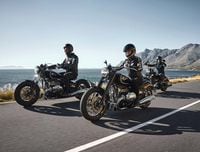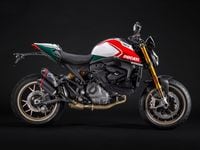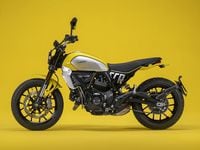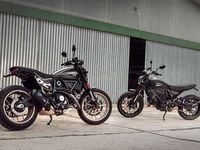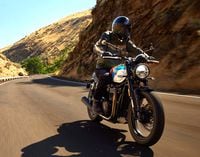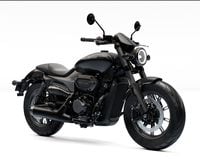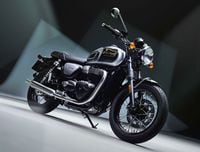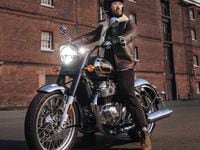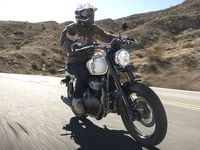Just when it looked like competition among big-inch cruisers was turning into a battle of wretched excess, Yamaha has returned to sanity with a big twin that delivers more of everything without crossing the line between "enough" and "too much." The new Star Roadliner is big, elegant and almost luxuriously comfortable but also easy to manage, responsive and more powerful than other members of the 100-cubic-inch club.
It didn't get there without some missteps along the way. Yamaha's first stab at its new maximum V-twin was a lot bigger than the 1853cc final product. Yamaha must have caught wind of Kawasaki's then-unannounced 2053cc Vulcan 2000, and the first Roadliner prototype it took to its product evaluation people was in the neighborhood of 2400cc. "That was not an enjoyable motorcycle," said one of Yamaha's American testers, who said the bike was too tall and heavy. The team went back to the drawing board with instructions to make the next version lower, less bulky and lighter overall.
The bike that eventually made it to production has a 48-degree air-cooled V-twin engine displacing 1854cc, making it shorter and lighter than the first effort. It rides in an aluminum frame with an aluminum swingarm. The aluminum not only saves weight-making the frame just 37 pounds (versus 62 pounds for the Road Star's steel item)-but is simpler (just eight pieces) and better lends itself to shaping in the interest of style, which is easy to see at the steering head and the swingarm.
Yamaha went all-out styling its new flagship. It took its inspiration from the Streamline era of design, with windswept shapes on everything from the handlebar clamps to the swingarm. Many small pieces bear artistic touches too. For example, the two-piece shift lever has nicely sculpted lines, the front fender strut has been carefully shaped, and the guards for the passenger footpegs have a pleasing stretched-teardrop contour. Instead of the massive fenders of some retro rides, the Roadliner's front fender is a bit leaner with a sweeping curve that fits the rest of the machine. The broad, seamless fuel tank appears to hold a lot, but it only accommodates 3.7 gallons because a big 3.5-liter airbox is tucked underneath it. The 0.8-gallon auxiliary tank under the seat brings the total fuel capacity to 4.5 gallons.
Yamaha says the Roadliner was intended to have "artistic style with room for technology." The engine combines those elements. Pushrod valve operation was chosen both for the look of those big, tapered pushrod tubes and the fact that it helps shorten the engine top-to-bottom, especially when combined with the Roadliner's dry sump lubrication system. The pushrods are actually shorter than the 1700 Road Star's. Air-cooling has a visual appeal too, especially after Yamaha machines and polishes the ends of those extra-deep fins. The 113-cubic-inch engine looks like the Road Star mill but is actually all new. Unlike the 1700, the 1900 has twin counterbalancers. It gets its own high-efficiency lubrication system. New four-valve heads have very straight intakes fed by a new twin-bore fuel-injection system with 43mm throttle bodies and 12-hole injector nozzles. On the exhaust side, a first for a cruiser, an EXUP (Exhaust Ultimate Power) valve adjusts back pressure for optimum power. The 100mm-wide pistons stroke through 118mm in plated cylinders.
Though Yamaha's previous flagships have made somewhat lethargic power, that's not the case with the Roadliner. Yamaha claims 91 horsepower and 117 foot-pounds of torque at the rear wheel (101 and 124 at the crankshaft). This bike definitely has muscle. In fact, it pulls harder than its Honda or Kawasaki counterparts. However, it has lost none of the wide power spread and easygoing delivery of previous Yamaha big twins. The Roadliner's drive starts way down low and grows quickly right to the 5000-rpm redline. The torque peak arrives at 2500 rpm, at which point it's running 65 mph in fifth gear, so top-gear passes are rapid. Throttle response is seamless and immediate with no abruptness.
The rest of the drive train is equally smooth. The hydraulic clutch requires a strong pull, but engages smoothly and predictably, making it easy to pull away without jerking your passenger. Gear changes are remarkably smooth and quiet. The engine has plenty of grunt off the bottom to let you jet away from a stop without a lot of revving or clutch slipping. There is enough flywheel inertia to keep the engine smooth but not so much that you have to be overly careful when synchronizing engine speed during downshifts.
The only engine issue we had was that it was sometimes reluctant to start when hot. A few times we had to crank it for 10 seconds before it would awaken. There is probably some sort of throttle setting that would resolve this, but we never found it.
We'd also like to mention the exhaust note. Several people were surprised that the pipes were stock based on the sound of the bike. Yamaha apparently got as close to the limit as possible. Owners who automatically change the exhaust system may want to reconsider that habit with this Star. Not only does the standard two-into-one system sound good, you'll almost certainly notice a power loss-in the range where you use it most-if you replace the full system by giving up the EXUP valve.
Yamaha claims that the Roadliner can get 200 miles between fill-ups, but the best we saw was 41 mpg, though that was cruising at a steady 75 mph. We never did ride it for any extended period at a steady 55 to 60 mph, which might return the over-45-mpg mileage needed to do that. The low-fuel light came on when it had consumed 4.0 gallons, leaving about half a gallon. At that point, the fuel gauge was just reaching the Empty peg. When the light comes on, the tripmeter resets to zero and starts counting up. So if you don't notice it right away, you have some idea of how much fuel and range you have left. We figure that half-gallon will get you 15 to 20 miles.
If you choose to use all the range of the Roadliner, your body probably won't complain. The seat is firm but not excessively so, which means it still provides good support at the end of the day. It is also flat and roomy, providing admirable comfort for riders of a variety of sizes from small to large, which was precisely what Yamaha intended. Taller riders have enough space to shift position, and the Roadliner might be a good fit for taller guys who complain that other bikes feel cramped. The oversized floorboards also permit you to shift position. Even Friedman's size 13s had room to rearrange themselves on extended rides.
When we first sat on one, we thought that the 37.6-inch-wide handlebar would hang us out in the wind like a sail and we'd be fighting to hold on. But it turns out the big headlight deflects enough wind from your torso that it isn't an issue. Running along at 75 or 80 mph, we'd just slide back on the seat and lean into the wind slightly, which balanced the wind pressure. Vibration is minimal and only the sharpest bumps intrude on your reverie.
One tester did 10 hours and almost 600 miles on the Roadliner on a variety of roads, stopping only for gas and one meal. His only complaint at the end of the day was that he was a bit chilled. Since the end of his ride was after dark, he also came back raving about the Roadliner's headlight, especially the high beam, and instrument lighting.
We didn't expect the Roadliner to be nimble, and it isn't. It wants to make nice, smooth, steady arcs into corners. It isn't a bike you flick into a bend. But that isn't to say that it requires a heavy steering effort. Perhaps because the long handlebar provides plenty of leverage, it initiates turns easily. However, if you want to lean over farther, you need to apply somewhat heavy pressure to bend it way over and hold it there. When we did so, we were surprised at how much cornering clearance it has. Previous Star flagships have been pretty limited in cornering clearance, but despite its long 67.5-inch wheelbase, the Roadliner offers respectable lean angle before the floorboards drag. (And Yamaha provides replaceable pads at the floorboard drag points to make it inexpensive to get rid of those grind marks if they bother you.)
The suspension is much better sorted out than most big cruisers'. The damping and spring rates provide excellent ride and stability, and only larger sharp-edged bumps disturb its progress at all. Whether droning along at 80 on an interstate or dragging its floorboards in a tight corner, the Roadliner felt as stately as it looks. Yamaha made a big point of the fact that the weight is balanced evenly between the two ends of the bike, putting more of its weight up front, which may have contributed to its stability.
The brakes also impress. They take a bit more lever pressure than a typical cruiser, but there is plenty of power there and excellent control. You aren't likely to inadvertently lock up either wheel. Full-boogie stops were straight and confident. Our only complaint was that handlebar-lever-position adjusters, a feature that Yamaha pioneered, have been dropped on the Roadliner in the interest of styling. The levers and master cylinder reservoirs were carefully shaped and finished (in chrome on the S models we tested), and it was apparently determined that the adjusters were unsightly. The Star accessory people may offer replacement levers with adjusters, which will allow smaller hands to get a better grip on things.
On the other side of the coin, there are a couple of eyesores that Yamaha let slip by. Yamaha made a major effort to style the steering-head area. One of the most notable (and controversial) styling touches is the chrome trim that wraps around the front of the fuel tank and extends up along the side of the steering head area of the frame, drawing your eye to it. Unfortunately, when your eye gets there, it is likely to be jarred by the big wire bundle sprawled across it on the right and a series of hoses (which we think are part of the emissions equipment for California models only) on the left. The wire bundle should have been routed under or through the frame, and we suspect Yamaha could have found a way to hide the maze of hoses.
There are plenty of nice details too. The ignition/fork lock atop the headlight has a sliding cover than pulls back to hide it and keep out grit and water when the key is removed. The face of the instrument pod atop the tank is nicely styled, and includes a small tachometer and fuel gauge. The LCD window includes a clock. Switches on the front of the handlebar switch housings reset and adjust the LCD display to a variety of configurations and also adjust instrument lighting level. We did have trouble reading the display in the rain, since the unit sits almost flat on the tank.
The Roadliner, like the forthcoming Stratoliner (the Roadliner with windshield, bags and passenger backrest), comes in three trim versions. The base model lists at $13,580 and is available only in black cherry. The Midnight ($13,880) blacks out many of the metal pieces and has black bodywork. We rode two examples of the S version, which has chrome finishes on most of the metal and polished wheels, comes in white ($14,780) or a bronze/black two-tone ($14,980).
After being less than overwhelmed by other companies' over-100-inch V-twins, the Star Roadliner is a welcome surprise. It is the first to deliver the kind of power that should come with this sort of displacement. Even though it appears the most nostalgic and least performance-oriented of the mega twins, it actually delivers the best handling and ride in the class. It also does the best job of providing the luxury and comfort that we expect from bikes in this niche. Finally, it also dispenses with traditional Star shortcomings like unimpressive power and too-little cornering clearance. While it will be a few months before we get to ride Suzuki's new big-inch V-twin, the Star Roadliner is clearly the standard that future big-displacement twins will have to beat.
High Points
* Roomy, flexible comfort* Strong power over a wide range* Impressive exhaust note* Beautifully shaped and finished components
Low Points
* Ugly hoses and wire bundles mar otherwise outstanding styling* Sometimes slow to start when hot* Lame horn
First Changes
* Hide that wire bundle on the right side of the steering head* Smaller hands will want adjustable handlebar levers if Yamaha offers them
Specifications
Yamaha Star Roadliner
Designation: XV1900
Suggested price: $13,580 (base model, black cherry); $13,880 (Midnight, black); $14,780 (S version, white), $14,980 (S version bronze/black)
Standard warranty: 12 months, unlimited miles
Engine & Drivetrain
Type: Air-cooled 48-degree tandem V-twin
Displacement, bore x stroke: 1854cc, 100 x 118mm
Compression ratio: 9.5:1
Carburetion: EFI, 43mm throttle bodies
Lubrication: Dry sump
Transmission: Wet, multiplate clutch; 5 speeds
Final drive: Belt
Chassis
Wet weight: 770 lb., 51% rear wheel
GVWR: 1213 lb.
Seat height: 28.9 in.
Wheelbase: 67.5 in.
Overall length: 101.6 in.
Wheels: Cast, 18 x 4.00 front, 17 x 5.50 rear
Front tire: 130/70R18 Dunlop D251F tubeless radial
Rear tire: 190/60R17 Dunlop D251F tubeless radial
Front brake: 2, 11.7-in. discs, 4-piston calipers
Rear brake: 12.6 in., disc, 2-piston caliper
Front suspension: 46mm stanchions, 5.1 in. travel
Rear suspension: One damper, 4.3 in. travel
Fuel capacity: 4.5 gal.
Handlebar: 37.6 in. wide, 1.0 in. diameter
Electrical & Instrumentation
Charging output: 450 watts
Forward lighting: 55/51-watt multi-reflector headlight, position lights
Taillight: LED
Instruments: Speedometer, tachometer, fuel gauge; LCD odometer, dual tripmeters, clock, ECU diagnosis; lights for high beam, neutral, low fuel, engine failure, left turn signal, right turn signal
Performance
Fuel mileage: 30-41 mpg, 35.9 mpg average
Average range: 162 miles
For more performance data visitwww.motorcyclecruiser.com/roadtests/XV19perf










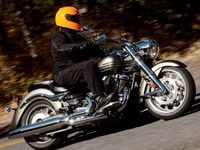
/cloudfront-us-east-1.images.arcpublishing.com/octane/H6Z2IC7WYRBXZNQS4MI3SZ5KPQ.jpg)
/cloudfront-us-east-1.images.arcpublishing.com/octane/IWO5T5PBT5E4HFQ5GK47H5YXR4.jpg)
/cloudfront-us-east-1.images.arcpublishing.com/octane/OQVCJOABCFC5NBEF2KIGRCV3XA.jpg)
/cloudfront-us-east-1.images.arcpublishing.com/octane/F3O2DGLA4ZBDJGNVV6T2IUTWK4.jpg)
/cloudfront-us-east-1.images.arcpublishing.com/octane/ZXYQE3MHLFDSPKNGWL7ER5WJ4U.jpg)
/cloudfront-us-east-1.images.arcpublishing.com/octane/RDF24VM7WVCOBPIR3V3R4KS63U.jpg)
/cloudfront-us-east-1.images.arcpublishing.com/octane/W7RSIBFISNHJLIJESSWTEBTZRQ.jpg)
/cloudfront-us-east-1.images.arcpublishing.com/octane/AERA26ENRNBW3K324YWCPEXYKM.jpg)
/cloudfront-us-east-1.images.arcpublishing.com/octane/YWX3YX7QBBHFXFDMEEEKRG4XJE.jpg)
/cloudfront-us-east-1.images.arcpublishing.com/octane/I7OKI53SZNDOBD2QPXV5VW4AR4.jpg)
/cloudfront-us-east-1.images.arcpublishing.com/octane/IH52EK3ZYZEDRD3HI3QAYOQOQY.jpg)
/cloudfront-us-east-1.images.arcpublishing.com/octane/K2FSAN7OWNAXRJBY32DMVINA44.jpg)
/cloudfront-us-east-1.images.arcpublishing.com/octane/G4XK7JL24FCUTKLZWUFVXOSOGE.jpg)
/cloudfront-us-east-1.images.arcpublishing.com/octane/JJNXVAC27ZCDDCMTHTQZTHO55Y.jpg)
